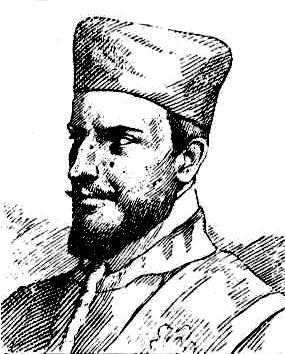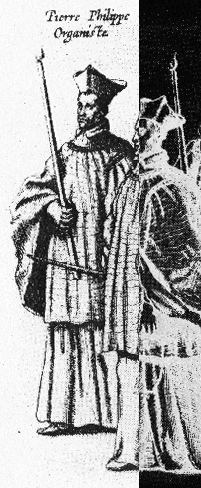Related Research Articles
Johann Pachelbel was a German composer, organist, and teacher who brought the south German organ schools to their peak. He composed a large body of sacred and secular music, and his contributions to the development of the chorale prelude and fugue have earned him a place among the most important composers of the middle Baroque era.

Francesco Cavalli was a Venetian composer, organist and singer of the early Baroque period. He succeeded his teacher Claudio Monteverdi as the dominant and leading opera composer of the mid 17th-century. A central figure of Venetian musical life, Cavalli wrote more than thirty operas, almost all of which premiered in the city's theaters. His best known works include Ormindo (1644), Giasone (1649) and La Calisto (1651).

Luigi Rossi was an Italian Baroque composer. Born in Torremaggiore, a small town near Foggia, in the ancient kingdom of Naples, at an early age he went to Naples where he studied music with the Franco-Flemish composer Jean de Macque, organist of the Santa Casa dell’Annunziata and maestro di cappella to the Spanish viceroy. Rossi later entered the service of the Caetani, dukes of Traetta.
Louis Couperin was a French Baroque composer and performer. He was born in Chaumes-en-Brie and moved to Paris in 1650–1651 with the help of Jacques Champion de Chambonnières. Couperin worked as organist of the Church of St. Gervais in Paris and as musician at the court. He quickly became one of the most prominent Parisian musicians, establishing himself as a harpsichordist, organist, and violist, but his career was cut short by his early death at the age of thirty-five.
Thomas Tomkins was a Welsh-born composer of the late Tudor and early Stuart period. In addition to being one of the prominent members of the English Madrigal School, he was a skilled composer of keyboard and consort music, and the last member of the English virginalist school.
Richard Farrant was an English composer, musical dramatist, theatre founder, and Master of the Children of the Chapel Royal. The first acknowledgment of him is in a list of the Gentlemen of the Chapel Royal in 1552. The year of his birth cannot be accurately determined. During his life he was able to establish himself as a successful composer, develop the English drama considerably, found the first Blackfriars Theatre, and be the first to write verse-anthems. He married Anne Bower, daughter of Richard Bower who was Master of the Chapel Royal choristers at the time. With Anne he conceived ten children, one of whom was also named Richard.
The year 1706 in music involved some significant events.

Peter Philips was an eminent English composer, organist, and Catholic priest exiled to Flanders in the Spanish Netherlands. He was one of the greatest keyboard virtuosos of his time, and transcribed or arranged several Italian motets and madrigals by such composers as Lassus, Palestrina, and Giulio Caccini for his instruments. Some of his keyboard works are found in the Fitzwilliam Virginal Book. Philips also wrote many sacred choral works.
Brian Mac Giolla Phádraig was an Irish poet and priest. He is not to be confused with any of the Barons of Upper Ossory, his relations, several of whom bore the same name in Irish.
Sebastian Anton Scherer was a German composer and organist of the Baroque era.
The decade of the 1530s in music involved some significant events, publications, compositions, births, and deaths.

Ercole Bernabei was an Italian composer, chapel master and organist.

Dr Benjamin Burrows was an English organist, pianist, music teacher, inventor, composer of art songs and instrumental music. He was known as a modest man and one of the finest teachers of his times.

Drexel 4180–4185 is a set of six manuscript partbooks copied in Gloucester, England, containing primarily vocal music dating from approximately 1615-1625. Considered one of the most important sources for seventeenth century English secular song, the repertoire included represents a mixture of sacred and secular music, attesting to the partbooks' use for entertainment and pleasure, rather than exclusively for liturgical use.

Osbert Parsley was an English Renaissance composer and chorister. Few details of his life are known, but he evidently married in 1558, and lived for a period in the parish of St Saviour's Church, Norwich. A boy chorister at Norwich Cathedral, Parsley worked there throughout his musical career. He was first mentioned as a lay clerk, was appointed a "singing man" in c. 1534, and was probably the cathedral's unofficial organist for half a century. His career spanned the reigns of Henry VIII and all three of his children. After the Reformation of 1534, the lives of English church musicians changed according to the official policy of each monarch.
Nicholas Strogers was an English composer, active between the years 1560 and 1575. Nothing is known about Strogers' early life and music education. Between Christmas 1564 and 1575, he was a parish clerk at St Dunstan-in-the-West, London, where he was in charge of the music and possibly also played the church organ.
Michel’Angelo Grancini was an Italian organist and composer. Grancini composed sacred music. Nineteen volumes were published in Milan (1622–29). Some 200 works are at the Milan Cathedral.
Elway Bevin (c.1554-1638) was a Welsh-born organist and composer.
James Hawkins was an English organist and composer of church music. He was for many years organist of Ely Cathedral.
References
- 1 2 Caldwell, J., & Memed, O. (2001). Cosyn, Benjamin. Grove Music Online. Retrieved 26 Dec. 2020.
- ↑ Memed, O. (2008). Cosyn, Benjamin (c. 1580–1653), organist and composer. Oxford Dictionary of National Biography. Retrieved 26 Dec. 2020